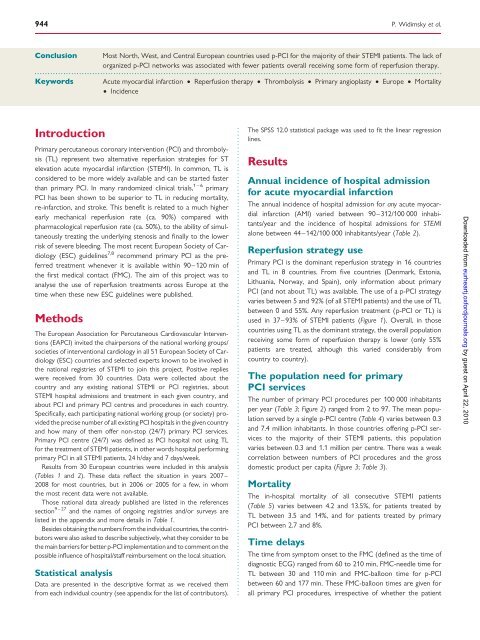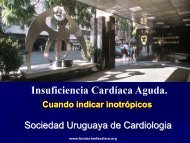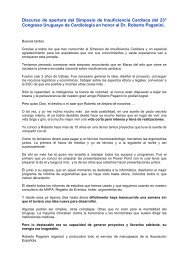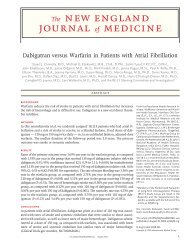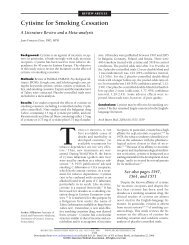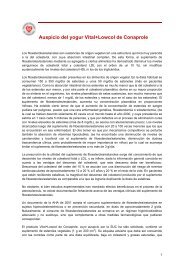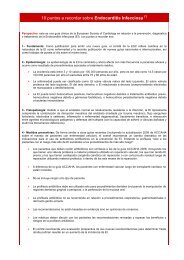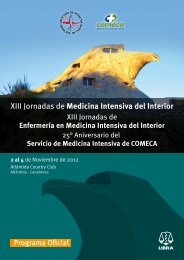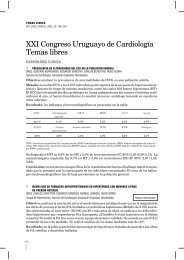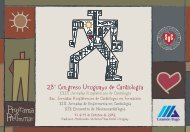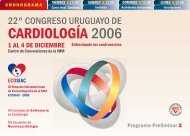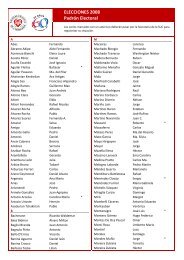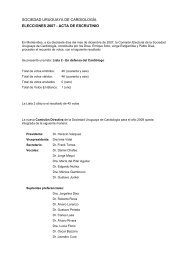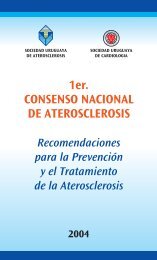Reperfusion therapy for ST elevation acute myocardial infarction in ...
Reperfusion therapy for ST elevation acute myocardial infarction in ...
Reperfusion therapy for ST elevation acute myocardial infarction in ...
Create successful ePaper yourself
Turn your PDF publications into a flip-book with our unique Google optimized e-Paper software.
944<br />
P. Widimsky et al.<br />
Conclusion<br />
Most North, West, and Central European countries used p-PCI <strong>for</strong> the majority of their <strong>ST</strong>EMI patients. The lack of<br />
organized p-PCI networks was associated with fewer patients overall receiv<strong>in</strong>g some <strong>for</strong>m of reperfusion <strong>therapy</strong>.<br />
-----------------------------------------------------------------------------------------------------------------------------------------------------------<br />
Keywords<br />
Acute <strong>myocardial</strong> <strong><strong>in</strong>farction</strong> † <strong>Reperfusion</strong> <strong>therapy</strong> † Thrombolysis † Primary angioplasty † Europe † Mortality<br />
† Incidence<br />
Introduction<br />
Primary percutaneous coronary <strong>in</strong>tervention (PCI) and thrombolysis<br />
(TL) represent two alternative reperfusion strategies <strong>for</strong> <strong>ST</strong><br />
<strong>elevation</strong> <strong>acute</strong> <strong>myocardial</strong> <strong><strong>in</strong>farction</strong> (<strong>ST</strong>EMI). In common, TL is<br />
considered to be more widely available and can be started faster<br />
than primary PCI. In many randomized cl<strong>in</strong>ical trials, 1–6 primary<br />
PCI has been shown to be superior to TL <strong>in</strong> reduc<strong>in</strong>g mortality,<br />
re-<strong><strong>in</strong>farction</strong>, and stroke. This benefit is related to a much higher<br />
early mechanical reperfusion rate (ca. 90%) compared with<br />
pharmacological reperfusion rate (ca. 50%), to the ability of simultaneously<br />
treat<strong>in</strong>g the underly<strong>in</strong>g stenosis and f<strong>in</strong>ally to the lower<br />
risk of severe bleed<strong>in</strong>g. The most recent European Society of Cardiology<br />
(ESC) guidel<strong>in</strong>es 7,8 recommend primary PCI as the preferred<br />
treatment whenever it is available with<strong>in</strong> 90–120 m<strong>in</strong> of<br />
the first medical contact (FMC). The aim of this project was to<br />
analyse the use of reperfusion treatments across Europe at the<br />
time when these new ESC guidel<strong>in</strong>es were published.<br />
Methods<br />
The European Association <strong>for</strong> Percutaneous Cardiovascular Interventions<br />
(EAPCI) <strong>in</strong>vited the chairpersons of the national work<strong>in</strong>g groups/<br />
societies of <strong>in</strong>terventional cardiology <strong>in</strong> all 51 European Society of Cardiology<br />
(ESC) countries and selected experts known to be <strong>in</strong>volved <strong>in</strong><br />
the national registries of <strong>ST</strong>EMI to jo<strong>in</strong> this project. Positive replies<br />
were received from 30 countries. Data were collected about the<br />
country and any exist<strong>in</strong>g national <strong>ST</strong>EMI or PCI registries, about<br />
<strong>ST</strong>EMI hospital admissions and treatment <strong>in</strong> each given country, and<br />
about PCI and primary PCI centres and procedures <strong>in</strong> each country.<br />
Specifically, each participat<strong>in</strong>g national work<strong>in</strong>g group (or society) provided<br />
the precise number of all exist<strong>in</strong>g PCI hospitals <strong>in</strong> the given country<br />
and how many of them offer non-stop (24/7) primary PCI services.<br />
Primary PCI centre (24/7) was def<strong>in</strong>ed as PCI hospital not us<strong>in</strong>g TL<br />
<strong>for</strong> the treatment of <strong>ST</strong>EMI patients, <strong>in</strong> other words hospital per<strong>for</strong>m<strong>in</strong>g<br />
primary PCI <strong>in</strong> all <strong>ST</strong>EMI patients, 24 h/day and 7 days/week.<br />
Results from 30 European countries were <strong>in</strong>cluded <strong>in</strong> this analysis<br />
(Tables 1 and 2). These data reflect the situation <strong>in</strong> years 2007–<br />
2008 <strong>for</strong> most countries, but <strong>in</strong> 2006 or 2005 <strong>for</strong> a few, <strong>in</strong> whom<br />
the most recent data were not available.<br />
Those national data already published are listed <strong>in</strong> the references<br />
section 9–27 and the names of ongo<strong>in</strong>g registries and/or surveys are<br />
listed <strong>in</strong> the appendix and more details <strong>in</strong> Table 1.<br />
Besides obta<strong>in</strong><strong>in</strong>g the numbers from the <strong>in</strong>dividual countries, the contributors<br />
were also asked to describe subjectively, what they consider to be<br />
the ma<strong>in</strong> barriers <strong>for</strong> better p-PCI implementation and to comment on the<br />
possible <strong>in</strong>fluence of hospital/staff reimbursement on the local situation.<br />
Statistical analysis<br />
Data are presented <strong>in</strong> the descriptive <strong>for</strong>mat as we received them<br />
from each <strong>in</strong>dividual country (see appendix <strong>for</strong> the list of contributors).<br />
The SPSS 12.0 statistical package was used to fit the l<strong>in</strong>ear regression<br />
l<strong>in</strong>es.<br />
Results<br />
Annual <strong>in</strong>cidence of hospital admission<br />
<strong>for</strong> <strong>acute</strong> <strong>myocardial</strong> <strong><strong>in</strong>farction</strong><br />
The annual <strong>in</strong>cidence of hospital admission <strong>for</strong> any <strong>acute</strong> <strong>myocardial</strong><br />
<strong><strong>in</strong>farction</strong> (AMI) varied between 90–312/100 000 <strong>in</strong>habitants/year<br />
and the <strong>in</strong>cidence of hospital admissions <strong>for</strong> <strong>ST</strong>EMI<br />
alone between 44–142/100 000 <strong>in</strong>habitants/year (Table 2).<br />
<strong>Reperfusion</strong> strategy use<br />
Primary PCI is the dom<strong>in</strong>ant reperfusion strategy <strong>in</strong> 16 countries<br />
and TL <strong>in</strong> 8 countries. From five countries (Denmark, Estonia,<br />
Lithuania, Norway, and Spa<strong>in</strong>), only <strong>in</strong><strong>for</strong>mation about primary<br />
PCI (and not about TL) was available. The use of a p-PCI strategy<br />
varies between 5 and 92% (of all <strong>ST</strong>EMI patients) and the use of TL<br />
between 0 and 55%. Any reperfusion treatment (p-PCI or TL) is<br />
used <strong>in</strong> 37–93% of <strong>ST</strong>EMI patients (Figure 1). Overall, <strong>in</strong> those<br />
countries us<strong>in</strong>g TL as the dom<strong>in</strong>ant strategy, the overall population<br />
receiv<strong>in</strong>g some <strong>for</strong>m of reperfusion <strong>therapy</strong> is lower (only 55%<br />
patients are treated, although this varied considerably from<br />
country to country).<br />
The population need <strong>for</strong> primary<br />
PCI services<br />
The number of primary PCI procedures per 100 000 <strong>in</strong>habitants<br />
per year (Table 3; Figure 2) ranged from 2 to 97. The mean population<br />
served by a s<strong>in</strong>gle p-PCI centre (Table 4) varies between 0.3<br />
and 7.4 million <strong>in</strong>habitants. In those countries offer<strong>in</strong>g p-PCI services<br />
to the majority of their <strong>ST</strong>EMI patients, this population<br />
varies between 0.3 and 1.1 million per centre. There was a weak<br />
correlation between numbers of PCI procedures and the gross<br />
domestic product per capita (Figure 3; Table 3).<br />
Mortality<br />
The <strong>in</strong>-hospital mortality of all consecutive <strong>ST</strong>EMI patients<br />
(Table 5) varies between 4.2 and 13.5%, <strong>for</strong> patients treated by<br />
TL between 3.5 and 14%, and <strong>for</strong> patients treated by primary<br />
PCI between 2.7 and 8%.<br />
Time delays<br />
The time from symptom onset to the FMC (def<strong>in</strong>ed as the time of<br />
diagnostic ECG) ranged from 60 to 210 m<strong>in</strong>, FMC-needle time <strong>for</strong><br />
TL between 30 and 110 m<strong>in</strong> and FMC-balloon time <strong>for</strong> p-PCI<br />
between 60 and 177 m<strong>in</strong>. These FMC-balloon times are given <strong>for</strong><br />
all primary PCI procedures, irrespective of whether the patient<br />
Downloaded from eurheartj.ox<strong>for</strong>djournals.org by guest on April 22, 2010


